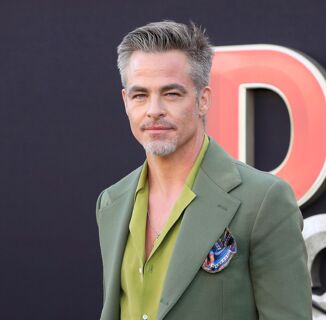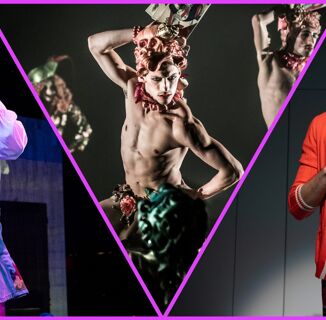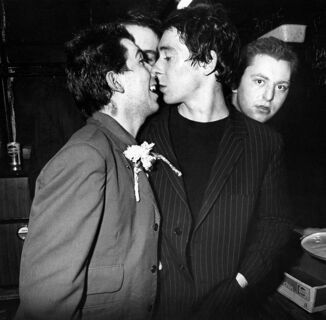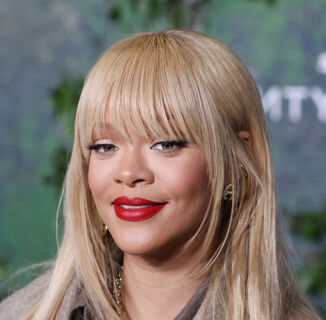In the 2005 movie The 40-Year-Old Virgin, the plight of Steve Carell’s title character was played for laughs. But in a society where coming out is becoming more common, and “gray divorce” is on the rise, there’s a new class of virgins — late in life lesbians who have yet to seal the Sapphic deal.
But what is virginity, really? A medical definition for cis women that involves the hymen seems irrelevant to Dr. Kelly Wise, an AASECT certified sex therapist and sex therapy supervisor in Brooklyn, NY.
“Everything that we know is that hymens can be not intact for many reasons that have nothing to do with intercourse,” Wise tells INTO. “So how relevant of a definition is that? Maybe in certain cultures where purity is discussed, but in our day and age, it just doesn’t feel relevant.”
What is relevant, says Wise, is that virginity is something a person offers. He points to similarities between sexual fluidity and the transgender experience. When those who have felt disconnected from their bodies take steps to align their internal sense of gender with their physical bodies, Wise says: “In the reclaiming of one’s self, there’s something powerful there. That reclamation is a new beginning.”
“I consider myself a lesbian virgin because I’ve never been intimate with a woman one-on-one,” 43-year-old JaTonna Kirkwood says. She’s been with a woman before, she says, but only in threesomes. With a man present, she thought it made her desires more socially acceptable.
Kirkwood describes her first eight-year marriage to a man as “all give and no receive.” Seven years after they divorced, he became terminally ill. “I was encouraged to get remarried because the ‘kids needed a father,’” Kirkwood tells INTO. This missive from friends and family led to a second round of hetero-marriage that was worse than the first — and that ended in divorce.
Post-marriage, looking for a person with the “internal beauty she seeks,” Kirkwood met a woman on a dating app. They developed an emotionally intimate relationship and explored Kirkwood’s past in phone conversations.
“I could see that I had picked abusive men because I didn’t feel worthy,” Kirkwood tells INTO. “I didn’t think being a lesbian made me worthy of a good relationship.”
Wise works with these populations and says that while past experiences are relevant and can’t be undone, they don’t have to define or have power over an individual. Each of us has the power to reclaim our virginity.
“This idea that virginity only happens once — and it’s said and done and you can’t have that back — is something that I challenge,” he tells INTO.
Since Kirkwood accepted herself as a lesbian, she says, “Everything makes sense.” She’s coming out to friends, she loves going to drag shows, and her belly-dancing “dance sister” is introducing her to the Kansas LGBTQ community. When she liked a lesbian event on Facebook recently, she says, a friend commented, “I knew it!”
Kate Ross from New South Wales, Australia is “58-years-young” and can’t remember hearing anything about lesbians as a Catholic teen ( “I would have been in my 20s before I had any idea about gay culture”). She had two brief hetero relationships at that time but nothing in the over three decades since. Sometimes she wonders if she might be asexual.
Ross has never kissed a girl, but she’s got her eye on a close lesbian friend who doesn’t know of Ross’s feelings. When she and her counselor discuss these issues, Ross uses the term “theoretical lesbian” instead of “virgin.”
“I have a whole bagful of anxieties about anything to do with lesbian sex,” Ross tells INTO. “It’s why I am not dating. I am scared stiff to let someone know I have had no experience. It’s eating away at me and I feel shameful about it. Crazy, I know. But that’s where I am at.”
These anxieties ring of adolescence and all of the fumbling and urgency that goes along with it. Wise says, “Any time we are trying something new, all of that anxiety comes up. Especially with the idea of ‘By this age, I should know all this stuff.’ But who’s to say that? I think it’s more important that people put themselves out there and try and be vulnerable.”
Ross’s counselor suggested a vibrator as a way for Ross to explore her sexuality. Once she figured out how it worked, she put it away for almost a month before she found the courage to use it again.
“I try to help my clients see that everything is a learning experience,” Wise tells INTO. “It’s not about having a successful experience. It’s more about, ‘What did I learn from this? What was good? What was not good? How do we move forward with what we learned?’ [It’s about] trying to lower the stakes from ‘Everything has to be A-plus perfect’ to ‘Let’s just put ourselves out there, try it, and see what we learn.’”
Manon Williams, a 40-year-old out lesbian in the San Francisco Bay Area, used to dream of a husband, a picket fence, and 2.5 children. She had two serious heterosexual relationships in her late 20s and 30s, but neither of them led to engagements. After she fell deeply in love with a straight female friend, she started questioning — and came out as a lesbian in July of this year.
“I’m still honing my gaydar,” Williams tells INTO. “I feel teenage awkward. Everything is new, scary, different and it feels like adolescence all over again.”
Adolescence is a time of self-discovery and vulnerability, and some older women are experiencing their new virginity with all the giddy excitement of a teen rom-com. Some, however, are struggling with internalized homophobia and self-acceptance while grieving the loss of a heterosexual-dream family. Some are healing from past scars. Still, others find themselves in a cycle of repetitive sexuality questioning.
“There’s this myth that everybody knows their own sexuality or this myth that we know exactly what the other person wants and we should be able to do it,” says Wise. “Regardless of who we’re attracted to, getting to know somebody is always two new people meeting, with two new sets of experiences, and two new erotic templates. It’s just having curiosity and an openness to hearing and understanding and taking it from there.”
If you’re one of the 3.4 million people who viewed Brene Brown’s TED Talk, you know that true happiness through deep connection between human beings often begins by being vulnerable. Our ability to love comes from our ability to accept love. But openness, and therefore vulnerability, can be difficult to access when we don’t feel worthy of love.
“Sometimes, in my fear, ” Williams says, “I wonder if I just haven’t met the right guy yet. But that comes from my inner homophobia and wanting to be ‘normal.’ I know I’ll have to kiss a lot of frogs before I find my princess. There will be pitfalls along the way.”
Trina Gable, 53, liked girls from the time she was six years old but didn’t understand the concept of the word lesbian until high school. “I shoved it aside and ignored it,” she says.
Married to a man for 16 years, Gable divorced in 2007. It was in 2017 — after she binge-watched The L Word, she says — that she reluctantly identified as a lesbian. “I couldn’t deny how I reacted to [the show] but I still wasn’t comfortable with [the label],” Gable tells INTO. She had been active in the United Pentecostal Church to keep her family’s approval and have a community.
Even though church elders told her it wouldn’t work, Gable says, “I basically tried to pray the gay away. I ignored it as much as possible and acted like it didn’t exist.”
The elders were right. A change in behavior will not alter or remove someone’s same-sex attraction. According to the Human Rights Campaign, not only is “conversion” or “reparative” therapy ineffective, but also, young people who are subjected to the practice are especially harmed. They can become depressed, turn to drug and substance abuse, or attempt to end their own lives. It’s a practice that sixteen states have banned and major medical, psychological, and professional organizations have denounced.
A year ago last October, Gable accepted herself as a lesbian — and this past summer, she came out to her family.
While Gable’s first woman love interest “drove her batty,” they never made it past the crush stage. Her first lesbian relationship lasted five months and included sexting and video sex, but they never met in person.
The fact that it takes some women longer to get to a point of being vulnerable is actually more normal than what is portrayed in movies and in porn. “People will come in and talk about watching this or that movie and feeling like a failure because they aren’t able to portray or live that — being able to please their partner quickly, understanding the other person’s body, frustrated that their own body isn’t responding as quickly as they’d like or as these things are portrayed,” says Dr. Wise. “Honestly that’s the exact thing that blocks and takes away your body’s chance to respond in the way you want.”
In her second long-distance relationship, Gable couldn’t stay away. “I had to meet her,” she says. “So, on the spur of the moment, I asked if I could see her.” They ended up spending the night together. “I knew neither of us had had sex with a woman, so I wasn’t worried if it didn’t go perfect.”
Sex after divorce can be scary independent of sexual orientation. A newly divorced person might feel a sense of guilt engaging intimately because they were bound by vows of monogamy; they might have middle-age body issues, or be a data point in the general drop in American sex rates. A 2017 study published in the Archives of Sexual Behavior showed that sexual frequency decreased most for those in their 50s and for those who were unpartnered. On the other end of the age spectrum, the 2015 national Youth Risk Behavior Survey (YRBS) showed that from 1991 to 2015, the percentage of teens who had ever engaged in sex fell 12.9 points.
Candi Tomlinson, age 70, who identifies as a demisexual lesbian, is waiting for an emotional connection before she has sex with a woman for the first time.
“I don’t have to have sex with a woman in order to know I want to,” Tomlinson tells INTO. “How do I know? I know by how my stomach jumps up to my throat when I see her. Or how my heart quickens when I see an email from her, or a phone call coming in. Or how I cry at night to lie next to her. That’s how I know, and why I wait.”
Image via Getty
Help make sure LGBTQ+ stories are being told...
We can't rely on mainstream media to tell our stories. That's why we don't lock our articles behind a paywall. Will you support our mission with a contribution today?
Cancel anytime · Proudly LGBTQ+ owned and operated
Read More in Culture
The Latest on INTO
Subscribe to get a twice-weekly dose of queer news, updates, and insights from the INTO team.
in Your Inbox














